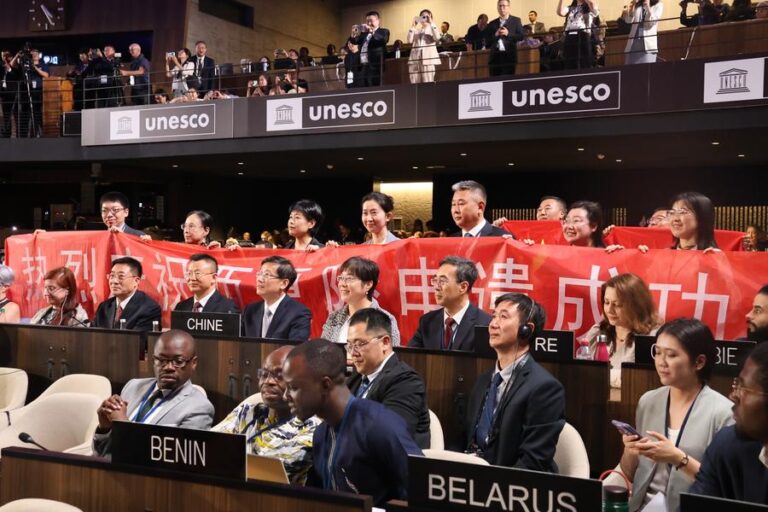* China’s Xixia Imperial Tombs, first built nearly 1,000 years ago, have been inscribed on the UNESCO World Heritage List.
* The site is a testament to the cultural fusion and interactions of diverse traditions.
* Xixia integrated Han Chinese traditions, Buddhist culture and distinct ethnic customs in its mausoleum system, exemplifying China’s pluralistic yet unified civilization.
YINCHUAN, July 12 (Xinhua) — The Xixia Imperial Tombs, first built nearly 1,000 years ago, have been inscribed on the World Heritage List, highlighting their role in showcasing a multicultural civilization based on agro-pastoralism and trade in northwest China.
The announcement was made on Friday during UNESCO’s 47th session of the World Heritage Committee held in Paris, France, bringing the total number of World Heritage sites in China to 60.
Located at the foot of Helan Mountain in Yinchuan, capital of Ningxia Hui Autonomous Region, the tombs were built by the Tangut, an ethnic group that thrived in northwest China between the 11th and 13th centuries.
Since excavations began in 1972, archaeologists have uncovered nine imperial tombs, 271 subordinate tombs, an architectural complex spanning five hectares, 32 flood control sites and over 7,100 artifacts — revealing the engineering, artistry and cultural achievements of the dynasty.
According to the World Heritage Committee, the site is a testament to the cultural fusion and interactions of diverse traditions. It also bears witness to the unique role of the Xixia Dynasty (1038-1227) in cultural and commercial exchanges along the Silk Road during the period.
The committee commended the efforts and achievements made by the Chinese government in the protection and management of the cultural heritage of the Xixia Imperial Tombs.
Rao Quan, vice minister of Culture and Tourism of China, said that China will remain steadfast in fulfilling its obligations under the World Heritage Convention, further enhance holistic and systematic protection of cultural and natural heritage, and improve conservation capacity and standards.
TESTAMENT TO CULTURAL EXCHANGE
In 1038, the Tangut people from the Qinghai-Tibet Plateau founded the Xixia Dynasty, establishing its capital in what is now Yinchuan. At its peak, its territory spanned 1.15 million square km, dominating the Hexi Corridor and serving as an ancient Silk Road hub. After 10 imperial reigns, the empire was destroyed by Genghis Khan’s Mongol army in 1227.
Records indicate that during the Xixia Dynasty, various ethnic groups, including the Tangut, Han, Uygur and Tibetan peoples, coexisted. Their diverse livelihoods, religious practices and cultural customs shaped Xixia’s distinctive and multifaceted cultural identity.
The tombs’ location, layout, architecture and artifacts demonstrate how the Xixia Dynasty adapted Han models during the Tang (618-907) and Song (960-1279) dynasties while infusing distinct ethnic features, said Shi Jinbo, a scholar in Xixia history.
Shi said that the tombs, which face the Yellow River and back against the Helan Mountain, mirrored the traditional mausoleum locations during the Song Dynasty. Additionally, distinctive features such as stupas with solid rammed earth interiors not only echo Khitan architectural styles but also embody Buddhist beliefs.
“These features enriched imperial burial traditions, making the tombs a unique ethnic landmark among China’s ancient mausoleums and showcasing Chinese civilization’s unity and inclusiveness,” he said.
Among the artifacts unearthed from the tombs, including stone carvings, ceramics, metalwork and textiles, a 1.52-meter-tall glazed Chiwen (a building component serving as roof ornament) from Tomb No. 6 showcased advanced glazing techniques.
“The glazed building components reveal how Xixia artisans adopted the craftsmanship from the Song Dynasty,” said Yu Jun, director of the history institute of the Ningxia Academy of Social Sciences.
MORE THAN PRESERVATION
From its first archaeological excavation in 1972, which confirmed the site’s “identity,” to its designation as a national key cultural site in 1988, then its inclusion on China’s World Heritage tentative list in 2012, and finally achieving UNESCO World Heritage status in 2025 — continuous efforts spanning five decades have transformed the Xixia Imperial Tombs into a globally celebrated heritage site.
After the World Heritage nomination process of the site was launched in July 2011, about 100,000 square meters of buildings and modern facilities were removed from the site, significantly improving conservation conditions, said Wang Changfeng, former deputy director of the Xixia Imperial Tombs management office.
He noted that the office also collaborated with the Dunhuang Academy and Ningxia University to address core conservation challenges.
In recent years, the site has enhanced exhibition offerings, featuring immersive extended reality experiences, interactive workshops, and over 700 cultural products that bring history to life, to help visitors appreciate the tombs’ heritage value.
“I’m amazed by the glazed ceramics and cultural fusion evident here,” said Ma Qing, a tourist from Shanghai.
French scholar Romain Lefebvre said that Xixia integrated Han Chinese traditions, Buddhist culture and distinct ethnic customs in its mausoleum system, exemplifying China’s pluralistic yet unified civilization.
“This multicultural synthesis makes the tombs crucial physical evidence for studying ancient ethnic relations, architectural arts and funerary traditions,” he told Xinhua in an exclusive interview via email.
Chen Tongbin, honorary chief of the Institute of Historical Research of the China Architecture Design and Research Group and a consultant for the site’s World Heritage nomination, said that as China’s economic rise draws global attention, efforts should be made to help the world better comprehend the essence of Chinese civilization.
“From this, we can reveal the historical wisdom created by our ancestors, as well as its significance for contemporary and future human development. This is the fundamental purpose of applying for World Heritage status,” she said. ■
(Video reporters: Ai Fumei, Feng Kaihua, Yang Zhisen, Ma Sijia and Luo Yu; video editors: Wang Han, Luo Hui, Zhou Sa’ang and Hong Liang)

